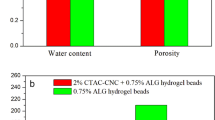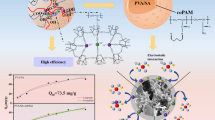Abstract
Cationic surfactant (CS) is one of the alarming emerging contaminants often found in municipal and industrial wastewater. Various research articles have already reported about the toxicity of CS. In the current research work, sustainable and green alginate (Ag) and alginate composite beads with xanthan gum (AgX) are explored for the adsorptive elimination of model CS, cetylpyridinium chloride (CPC) and cetyltrimethylammonium bromide (CTAB), from wastewater. The composite (AgX) beads showed relatively better performance than Ag beads in terms of mechanical strength and equilibrium time. Studies on FTIR spectra, SEM analysis, size distribution, pHzpc measurement, and elemental analyses were conducted in order to characterize the adsorbent and to get an insight into the adsorption phenomenon. At the end of 8 days’ equilibrium time, the maximum adsorptive retention capacity of the AgX beads was obtained as ~ 310 mg/g with an initial CPC concentration of 600 mg/L, using an adsorbent dose of 1.5 g/L. A layered isotherm with varying slopes was obtained, indicating different stages of CPC adsorption. CPC uptake by hydrogel beads was associated with significant shrinkage of the beads. Removal of CPC from real wastewater was possible with good efficiency. The effect of pH and interfering ions on CPC removal was examined. The results showed that the pH range of 5.5–6 was the optimum, and there was no interference from Co(II), Ni(II), and Mg(II) ions. The results showed good reproducibility with a relative standard deviation (RSD) < ± 10%.








Similar content being viewed by others
Data availability
The datasets used and/or analyzed during the current study are available from the corresponding author on reasonable request.
References
Abas SNA, Ismail MHS, Siajam SI, Kamal ML (2015) Development of novel adsorbent-mangrove-alginate composite bead (MACB) for removal of Pb(II) from aqueous solution. J Taiwan Inst Chem Eng 50:182–189. https://doi.org/10.1016/j.jtice.2014.11.013
Abdelhamid HN, Lin YC, Wu H (2017) Magnetic nanoparticle modified chitosan for surface enhanced laser desorption/ionization mass spectrometry of surfactants. RSC Adv 7:41585–41592. https://doi.org/10.1039/C7RA05982E
Adak A, Bandyopadhyay M, Pal A (2005a) Removal of anionic surfactant from wastewater by alumina: A case study. Colloids Surf A Physicochem Eng Asp 254:165–171. https://doi.org/10.1016/j.colsurfa.2004.12.004
Adak A, Bandyopadhyay M, Pal A (2005b) Adsorption of anionic surfactant on alumina and reuse of the surfactant-modified alumina for the removal of crystal violet from aquatic environment. J Environ Sci Heal A 40:167–182
Aida TM, Yamagata T, Watanabe M, Smith RL (2010) Depolymerization of sodium alginate under hydrothermal conditions. Carbohydr Polym 80:296–302. https://doi.org/10.1016/j.carbpol.2009.11.032
Arslan A, Topkaya E, Bingol D, Veli S (2018) Removal of anionic surfactant sodium dodecyl sulfate from aqueous solutions by O3/UV/H2O2 advanced oxidation process: Process optimization with response surface methodology approach. Sustain Environ Res 28:65–71. https://doi.org/10.1016/j.serj.2017.11.002
Bae S, Mannan MB, Lee W (2012) Adsorption of cationic cetylpyridinium chloride on pyrite surface. J Ind Eng Chem 18:1482–1488. https://doi.org/10.1016/j.jiec.2012.02.010
Bezerra KGO, Rufino RD, Luna JM, Sarubbo LA (2018) Saponin and microbial biosurfactants: potential raw materials for the formulation of cosmetics. Biotechnol Prog. https://doi.org/10.1002/btpr.2682
Biswas S, Pal A (2020a) Spectrophotometric determination of cationic surfactants in aqueous media using chrome azurol S as colour forming agent and 1-butanol as extracting solvent. Talanta 206:120238. https://doi.org/10.1016/j.talanta.2019.120238
Biswas S, Pal A (2020b) Visible light assisted Fenton type degradation of methylene blue by admicelle anchored alumina supported rod shaped manganese oxide. J Water Proc Eng 36:101272. https://doi.org/10.1016/j.jwpe.2020.101272
Biswas S, Pal A (2021a) Application of biopolymers as a new age sustainable material for surfactant adsorption: a brief review. Carbohydr Polym Technol Appl 2:100145. https://doi.org/10.1016/j.carpta.2021.100145
Biswas S, Pal A (2021b) Iron-oxide alginate-bentonite hydrogel beads as a green and sustainable catalyst for 4-nitrophenol reduction. Mater Today Commun 28:102588. https://doi.org/10.1016/j.mtcomm.2021.102588
Biswas S, Pal A (2022) Fabrication of a novel composite gel bead to reclaim methyl orange from a binary dye mixture: an active role of adsolubilization phenomenon. Mater Today Commun 33:104386. https://doi.org/10.1016/j.mtcomm.2022.104386
Chattaraj S, Das AK (1992) Indirect AAS determination of cationic surfactants in waste effluents and shampoos. Anal Lett 25:2355–2366. https://doi.org/10.1080/00032719208017967
Collivignarelli MC, Miino MC, Baldi M, Manzi S, Abba A, Bertanza G (2019) Removal of non-ionic and anionic surfactants from real laundry wastewater by means of a full-scale treatment system. Proc Safety Environ Protec 132:105–115. https://doi.org/10.1016/j.psep.2019.10.022
Dadebo D, Ibrahim MG, Fujii M, Nasr M (2023) Sequential treatment of surfactant-laden wastewater using low-cost rice husk ash coagulant and activated carbon: Modeling, optimization, characterization, and techno-economic analysis. Bioresour Technol Rep 22:101464. https://doi.org/10.1016/j.biteb.2023.101464
Dalvie MA, Sinanovic E, London L, Cairncross E, Solomon A, Adam H (2005) Cost analysis of ELISA, solid-phase extraction, and solid-phase microextraction for the monitoring of pesticides in water. Environ Res 98:143–150. https://doi.org/10.1016/j.envres.2004.09.002
Das D, Pal A (2016) Adsolubilization phenomenon perceived in chitosan beads leading to a fast and enhanced malachite green removal. Chem Eng J 290:371–380. https://doi.org/10.1016/j.cej.2016.01.062
Gonzalez S, Petrovic M, Barcelo D (2007) Removal of a broad range of surfactants from municipal wastewater—comparison between membrane bioreactor and conventional activated sludge treatment. Chemosphere 67:335–343. https://doi.org/10.1016/j.chemosphere.2006.09.056
Khosravi A, Karimi M, Ebrahimi H, Fallah N (2020) Sequencing batch reactor/nanofiltration hybrid method for water recovery from textile wastewater contained pthalocyanine dye and anionic surfactant. J Environ Chem Eng 8:103701. https://doi.org/10.1016/j.jece.2020.103701
Koner S, Pal A, Adak A (2010) Cationic surfactant adsorption on silica gel and its application for wastewater treatment. Desalin Water Treat 22:1–8. https://doi.org/10.5004/dwt.2010.1465
Kralova I, Sjoblom J (2009) Surfactants used in food industry: a review. J Disp Sci Technol 30:1363–1383. https://doi.org/10.1080/01932690902735561
Liu S, Chen M, Cao X, Li G, Zhang D, Li M, Meng N, Yin J, Yan B (2020) Chromium (VI) removal from water using cetylpyridinium chloride (CPC)-modified montmorillonite. Sep Purif Technol 241:116732. https://doi.org/10.1016/j.seppur.2020.116732
Liu L, Ge Y, Liu X, Ruan J, Cao J, Wei C, Fang P, Zhou J, Ma J, Tong Z (2021) One-pot ball-milling preparation of cetylpyridinium chloride/α-zirconium phosphate composite for simultaneous detection of ascorbic acid and dopamine. J Alloys Compd 860:157927. https://doi.org/10.1016/j.jallcom.2020.157927
Liwarska-Bizukojc E, Bizukojc M (2006) Effect of selected anionic surfactants on activated sludge flocs. Enzyme Microb Technol 39:660–668. https://doi.org/10.1016/j.enzmictec.2005.11.020
Mishra SK, Kanungo SB, Rajeev (2003) Adsorption of sodium dodecyl benzenesulfonate onto coal. J Colloid Interf Sci 267:42–48. https://doi.org/10.1016/S0021-9797(03)00553-8
Nalecz-Jawecki G, Grabinska-Sota E, Narkiewicz P (2003) The toxicity of cationic surfactants in four bioassays. Ecotoxicol Environ Safety 54:87–91. https://doi.org/10.1016/S0147-6513(02)00025-8
Obeid L, Kolli NE, Dali N, Talbot D, Abramson S, Welschbilig M, Cabuil V, Bee A (2014) Adsorption of a cationic surfactant by a magsorbent based on magnetic alginate beads. J Colloid Interf Sci 432:182–189. https://doi.org/10.1016/j.jcis.2014.06.027
Oztekin N, Erim FB (2005) Determination of cationic surfactants as the preservatives in an oral solution and a cosmetic product by capillary electrophoresis. J Pharm Biomed Anal 37:1121–1124. https://doi.org/10.1016/j.jpba.2004.07.050
Pal P, Pal A (2017) Enhanced Pb2+ removal by anionic surfactant bilayer anchored on chitosan bead surface. J Mol Liq 248:713–724. https://doi.org/10.1016/j.molliq.2017.10.103
Pal P, Pal A (2019) Treatment of real wastewater: kinetic and thermodynamic aspects of cadmium adsorption onto surfactant-modified chitosan beads. Int J Biol Macromol 131:1092–1100. https://doi.org/10.1016/j.ijbiomac.2019.03.121
Pashaei-Fakhri S, Peighambardoust SJ, Foroutan R, Arsalani N, Ramavandi B (2021) Crystal violet dye sorption over acrylamide/graphene oxide bonded sodium alginate nanocomposite hydrogel. Chemosphere 270:129419. https://doi.org/10.1016/j.chemosphere.2020.129419
Pavan PC, Gomes GA, Valim JB (1998) Adsorption of sodium dodecyl sulphate on layered double hydroxides. Micropor Mesopor Mater 21:659–665. https://doi.org/10.1016/S1387-1811(98)00054-7
Pongjanyakul T, Puttipipatkhachorn S (2007) Xanthan-alginate composite gel beads: molecular interaction and in vitro characterization. Int J Pharm 331:61–71. https://doi.org/10.1016/j.ijpharm.2006.09.011
Purakayastha PD, Pal A, Bandyopadhyay M (2005) Sorption kinetics of surfactant on to waste tire rubber granules. Sep Purif Technol 46:129–135. https://doi.org/10.1016/j.seppur.2005.04.011
Saber-Samandari S, Saber-Samandari S, Joneidi-Yekta H, Mohseni M (2017) Adsorption of anionic and cationic dyes from aqueous solution using gelatin-based magnetic nanocomposite beads comprising carboxylic acid functionalized carbon nanotube. Chem Eng J 308:1133–1144
Sanchez-Martin J, Beltran-Heredia J, Gibello-Perez P (2011) Adsorbent biopolymers from tannin extracts for water treatment. Chem Eng J 168:1241–1247. https://doi.org/10.1016/j.cej.2011.02.022
Schuricht F, Borovinskaya ES, Reschetilowski W (2017) Removal of perfluorinated surfactants from wastewater by adsorption and ion exchange-Influence of material properties, sorption mechanism and modelling. J Environ Sci 54:160–170. https://doi.org/10.1016/j.jes.2016.06.011
Sellimi S, Younes I, Ayed HB, Maalej H, Montero V, Rinaudo M, Dahia M, Mechichi T, Hajji M, Nasri M (2015) Structural, physicochemical and antioxidant properties of sodium alginate isolated from a Tunisian brown seaweed. Int J Biol Macromol 72:1358–1367. https://doi.org/10.1016/j.ijbiomac.2014.10.016
Shami S, Dash RR, Verma AK, Dash AK, Pradhan A (2019) Adsorptive removal of surfactant using dolochar: a kinetic and statistical modeling approach. Water Environ Res. https://doi.org/10.1002/wer.1193
Wang W, Wang A (2010) Synthesis and swelling properties of pH-sensitive semi-IPN superabsorbent hydrogels based on sodium alginate-g-poly(sodium acrylate) and polyvinylpyrrolidone. Carbohydr Polym 80:1028–1036. https://doi.org/10.1016/j.carbpol.2010.01.020
Wang Y, Wang W, Shi X, Wang A (2013) A superabsorbent nanocomposite based on sodium alginate and illite/smectite mixed-layer clay. Appl Polym Sci. https://doi.org/10.1002/APP.39141
Zhang S, Xu F, Wang Y, Zhang W, Peng X, Pepe F (2013) Silica modified calcium alginate-xanthan gum hybrid bead composites for the removal and recovery of Pb(II) from aqueous solution. Chem Eng J 234:33–42. https://doi.org/10.1016/j.cej.2013.08.102
Zhang W, Xu F, Wang Y, Luo M, Wang D (2014) Facile control of zeolite NaA dispersion into xanthan gum-alginate binary biopolymer network in improving hybrid composites for adsorptive removal of Co2+ and Ni2+. Chem Eng J 255:316–326. https://doi.org/10.1016/j.cej.2014.06.024
Acknowledgements
The authors are grateful to IIT Kharagpur for providing instrumental facilities and Ministry of Education, Government of India for providing financial support. Besides that, the authors would like to thank Miss Anuja Joseph (research scholar of School of Environmental Science and Engineering, IIT Kharagpur) for her help in bacteriological test.
Funding
None.
Author information
Authors and Affiliations
Contributions
SB was involved in the conceptualization, writing and original draft preparation, investigation. AN was involved in writing-reviewing and editing, conceptualization. AP was involved in supervision, writing-reviewing and editing, conceptualization. All authors read and approved the final manuscript.
Corresponding author
Ethics declarations
Competing interests
The authors declare no competing interests.
Ethics approval and consent to participate
No animals or human beings, human data or human tissue were used in this study.
Additional information
Editorial responsibility: Samareh Mirkia.
Supplementary Information
Below is the link to the electronic supplementary material.
Rights and permissions
Springer Nature or its licensor (e.g. a society or other partner) holds exclusive rights to this article under a publishing agreement with the author(s) or other rightsholder(s); author self-archiving of the accepted manuscript version of this article is solely governed by the terms of such publishing agreement and applicable law.
About this article
Cite this article
Biswas, S., Nath, A. & Pal, A. Fabrication of a novel alginate-xanthan biopolymer hydrogel bead for cationic surfactant removal from aqueous medium. Int. J. Environ. Sci. Technol. 21, 6663–6676 (2024). https://doi.org/10.1007/s13762-023-05421-7
Received:
Revised:
Accepted:
Published:
Issue Date:
DOI: https://doi.org/10.1007/s13762-023-05421-7




